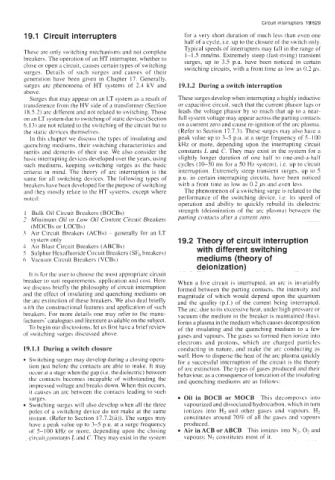Page 664 - Industrial Power Engineering and Applications Handbook
P. 664
Circuit interrupters 191629
19.1 Circuit interrupters for a very short duration of much less than even one
half of a cycle, i.e. up to the closure of the switch only.
Typical speeds of interrupters may fall in the range of
These are only switching mechanisms and not complete 1-1 .S mm/ms. Extremely steep (fast-rising) transient
breakers. The operation of an HT interrupter, whether to surges, up to 3.5 p.u. have been noticed in certain
close or open a circuit, causes certain types of switching switching circuits, with a front time as low as 0.2 pus.
surges. Details of such surges and causes of their
generation have been given in Chapter 17. Generally,
surges are phenomena of HT systems of 2.4 kV and 19.1.2 During a switch interruption
above.
Surges that may appear on an LT system as a result of These surges develop when interrupting a highly inductive
transference from the HV side of a transformer (Section or capacitive circuit, such that the current phasor lags or
18.5.2) are different and not related to switching. Those leads the voltage phasor by so much that up to a near-
on an LT system due to switching of static devices (Section full system voltage may appear across the parting contacts
6.13) are not related to the switching of the circuit but to on a current zero and cause re-ignition of the arc plasma.
the static devices themselves. (Refer to Section 17.7.3). These surges may also have a
In this chapter we discuss the types of insulating and peak value up to 3-5 p.u. at a surge frequency of 5-1 00
quenching mediums, their switching characteristics and kHz or more, depending upon the interrupting circuit
merits and demerits of their use. We also consider the constants L and C. They may exist in the system for a
basic interrupting devices developed over the years, using slightly longer duration of one half to one-and-a-half
such mediums, keeping switching surges as the basic cycles (10-30 ms for a 50 Hz system), i.e. up to circuit
criteria in mind. The theory of arc interruption is the interruption. Extremely steep transient surges, up to 5
same for all switching devices. The following types of p.u, in certain interrupting circuits. have been noticed
breakers have been developed for the purpose of switching with a front time as low as 0.2 ps and even le\a.
and they mostly relate to the HT systems, except where The phenomenon of a switching surge is related to the
noted: performance of the switching device, i.e. its speed of
operation and ability to quickly rebuild its dielectric
I Bulk Oil Circuit Breakers (BOCBs) strength (deionization of the arc plasma) between the
2 Minimum Oil or Low Oil Content Circuit Breakers parting contacts after a current zero.
(MOCBs or LOCBs)
3 Air Circuit Breakers (ACBs) - generally for an LT
system only 19.2 Theory of circuit interruption
4 Air Blast Circuit Breakers (ABCBs) with different switching
5 Sulphur Hexafluoride Circuit Breakers (SF6 breakers)
6 Vacuum Circuit Breakers (VCBs) mediums (theory of
deionization)
It is for the user to choose the most appropriate circuit
breaker to suit requirements. application and cost. Here When a live circuit is interrupted, an arc is invariably
we discuss briefly the philosophy of circuit interruption formed between the parting cbntacts. the intensity and
and the effect of insulating and quenching mediums on magnitude of which would depend upon the quantum
the arc extinction of these breakers. We also deal briefly and the quality (p.f.) of the current being interrupted.
with the constructional features and application of such The arc, due to its excessive heat, under high pressure or
breakers. For more details one may refer to the manu- vacuum (the medium in the breaker is maintained thus),
facturers' catalogues and literature available on the subject. forms a plasma in the medium which causes decomposition
To begin our discussions, let us first have a brief review of the insulating and the quenching medium to a few
of switching surges discussed above. gases and vapours. The gases so formed then ionize into
electrons and protons, which are charged particles
19.1.1 During a switch closure conducting in nature, and make the arc conducting as
well. How to disperse the heat of the arc plasma quickly
Switching surges may develop during a closing opera- for a successful interruption of the circuit is the theory
tion just before the contacts are able to make. It may of arc extinction. The types of' gases produced and their
occur at a stage when the gap (i.e. the dielectric) between behaviour, as a consequence of ionization of the insulating
the contacts becomes incapable of withstanding the and quenching mediums are as follows:
impressed voltage and breaks down. When this occurs,
it causes an arc between the contacts leading to such
surges. Oil in BOCB or MOCB This decornposcs into
Switching surges will also develop when all the three vapourized and dissociated hydrocarbon. which in turn
poles of a switching device do not make at the same ionizes into H2 and other gases and vapours. H2
instant. (Refer to Section 17.7.2(ii)). The surges may constitutes around 70% of all the gases and vapours
have a peak value up to 3-5 p.u. at a surge frequency produced.
of 5-100 kHz or more, depending upon the closing Air in ACB or ABCB This ionizes into N2. O2 and
circuit constants Land C. They may exist in the system vapours; N? constitutes most of it.

